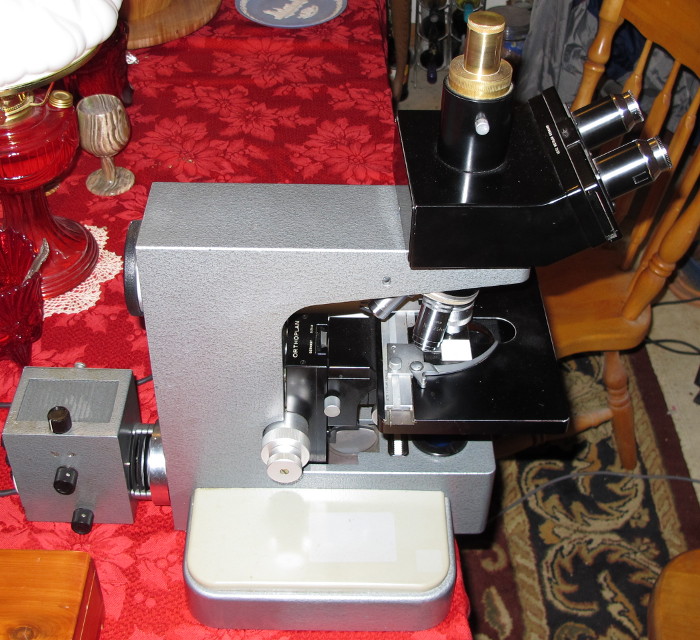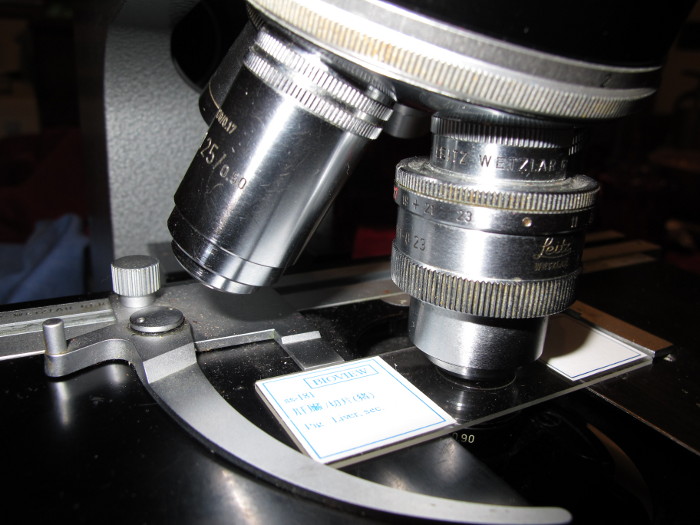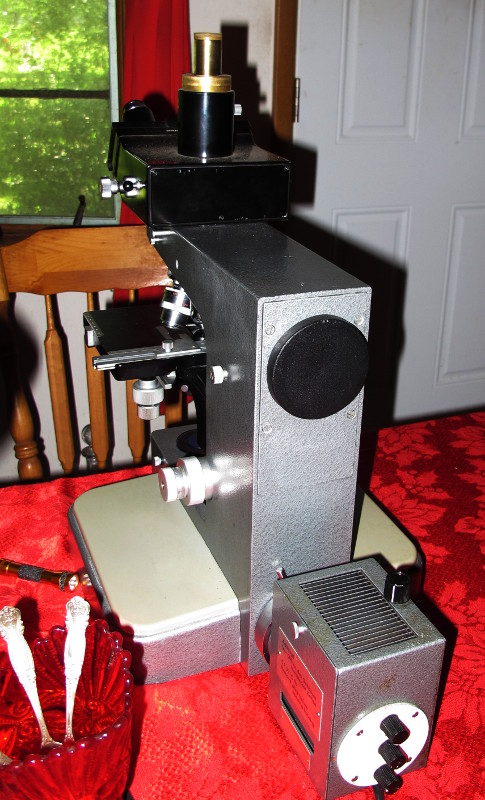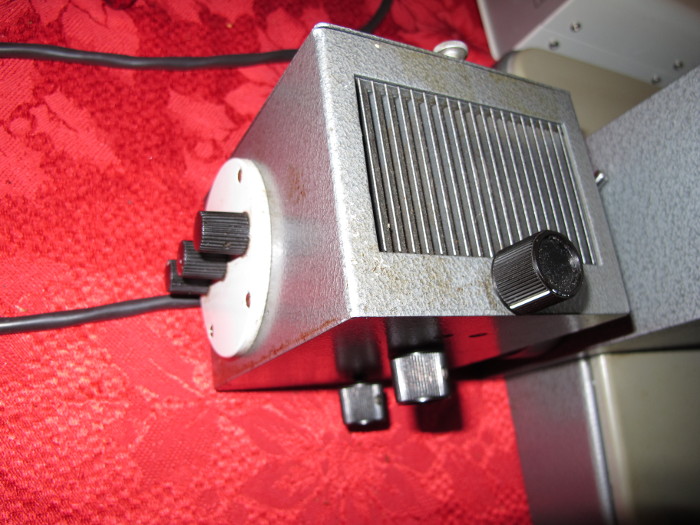Bringing an Orthoplan back to Health
Robert Pavlis, Girard, Kansas USA
About 12 years ago I acquired an Orthoplan microscope at a bargain price. I have often done things to improve it, and I often have looked for accessories to use to improve it.
 A few weeks ago while looking for some accessories for it, I came upon an eBay auction that featured an Orthoplan without head or power supply. It came with three Leitz objectives. The bidding was at $US59, and the auction was scheduled to end in about an hour. I ended up getting it for $US321. It arrived in an enormous box about five or six days later.
A few weeks ago while looking for some accessories for it, I came upon an eBay auction that featured an Orthoplan without head or power supply. It came with three Leitz objectives. The bidding was at $US59, and the auction was scheduled to end in about an hour. I ended up getting it for $US321. It arrived in an enormous box about five or six days later.
I opened the box and lifted it out, it was well packed. All of the modules that were present were in place on the microscope rather than packed separately. I sat the monster on the kitchen table. It was dirty, and there were no less than nine gummed labels stuck on it in various places. Almost all were worn and illegible. There were white spots all over it, at least a two dozen of them. The base on the left side had a strange stain on it that looked like varnish. There were two large scratches on the
square 9x9cm front of the instrument.
This was one of the hammer tone finished models, made after the initial black run in the mid and late 1960s. The Leitz seal on it is rectangular, but oddly it is very dark grey, almost black, not blue. (Orthoplans produced in the 1970s and later had red seals of at least three designs.)
Another peculiarity of the instrument is the 100z lamp house. It is painted in the hammer tone grey of the 1960s. However it has a quartz bulb system, and early 100 series lamp houses apparently used the flat filament bulbs that were attached to the back part of the lamp house. The mirror focusing system on this instrument is painted in the last Orthoplan colour, the ivory one. Apparently Leitz made an ``upgrade'' kit to convert flat filament lamp houses into the top of the line 100z, and this must have
been added in the late 1980s or later.
I released the objective turret and removed it. I swapped it with the one in my existing Orthoplan. I first checked the 2.5X flat field objective with a slide I like to for testing. This objective was truly wonderful.
 I checked the 10x flat field. It was just as wonderful.
I checked the 10x flat field. It was just as wonderful.
Now I switched to the third and last objective on the turret. This was a 40x apo with n.a. = 0.95. I brought it into focus. The image was really ``soft''. I checked the cover glass correction collar, it was set for maximum cover glass thickness. I adjusted it visually, and soon the image was wonderful! This alone was worth more than the $US321 I had paid for the package.
Another thing I wanted from this purchase was the condenser. I removed it and put it into the existing Orthoplan. Then I discovered someone had oiled the iris on the condenser, and the oil had hardened. Because I am a chemist, I knew very well how to deal with this situation. It calls for using an aliphatic hydrocarbon solvent. (Aromatic solvents tend to be bad, and oxygen containing compounds often are too. Chlorinated solvents tend to create a disaster.) A good aliphatic solvent is Coleman lantern fuel.
Modern formulations are free of aromatic compounds, and are short aliphatic and alicyclic compounds. I did the following outside: I used a dropper to squirt this against the iris of the condenser with the condenser on its side so the excess ran out. I waited a while and then repeated the operation. Then I discovered the iris could be now closed. I closed it and squirted two more shots of fuel at it. I opened and closed the iris many times and then with the iris fully open I squirted a bit more fuel against
the bottom lens, since it had been contaminated by the previous efforts. I cleaned the bottom element with several layers of lens tissue wrapped over a wooden chop stick. I cleaned the top of the lower lens element, and then the ``flip flop'' top element. I checked the whole thing and put it back into my functioning Orthoplan. It now worked wonderfully! It was literally like new!
 I returned to the sad looking Orthoplan on the table. I tried to remove the condenser focusing module, but the lock knob was frozen. I put a few drops of sewing machine oil on it and waited about fifteen minutes. Then I was able to turn it with a pliers wrapped in cloth. It took more force than usual, but I then was able to remove the condenser focusing module by moving it down its dovetail. I rinsed its track with more Coleman fuel. I also rinsed the track on the stage module where it is attached the
same way. I put a thin film of oil on the track. Now I ran a mixture of sewing machine oil and special camera lens thread lubricant I had in stock down the rack and pinion of the condenser. I collected excess oil that ran down, and then dried off all the surfaces. I put the condenser focusing module in a soup bowl to be sure all the excess oil I had put into the rack and pinion would run out.
I returned to the sad looking Orthoplan on the table. I tried to remove the condenser focusing module, but the lock knob was frozen. I put a few drops of sewing machine oil on it and waited about fifteen minutes. Then I was able to turn it with a pliers wrapped in cloth. It took more force than usual, but I then was able to remove the condenser focusing module by moving it down its dovetail. I rinsed its track with more Coleman fuel. I also rinsed the track on the stage module where it is attached the
same way. I put a thin film of oil on the track. Now I ran a mixture of sewing machine oil and special camera lens thread lubricant I had in stock down the rack and pinion of the condenser. I collected excess oil that ran down, and then dried off all the surfaces. I put the condenser focusing module in a soup bowl to be sure all the excess oil I had put into the rack and pinion would run out.
Meanwhile I removed the stage. The stage lock knob was not seized, and the stage came off with no difficulty. I put some of the oil-camera grease mixture down the main focusing mechanism with a paper towel under it to catch any excess that might run through. I ran the focusing mechanism up and down. It became smoother, but it was in good condition before, it was better now, however! I wiped away all excess oil from the stage mount and turned my attention to the stage. I carefully lubricated the mechanical
stage mechanism and dried off all excess oil. This also made it move like a truly new instrument. I wiped off the dovetail on the stage mount, and the receiving dovetail on the focusing mechanism and put a very thin film of oil on both.
I checked everything and put everything back on the microscope frame! I re checked out everything, and the stage, condenser mount, and condenser were all perfect!
Now I turned my attention to the lamp house. This instrument came with the somewhat deluxe 100Z lamp house. This has six adjustments, three on the back for a reflecting mirror, two on the left side, one to move the lamp back and forth, and the other to focus a lens in front of the lamp, and one on top to move the lamp up and down. The ones on the back and side were in excellent condition, but the one on top was frozen.
I tried to remove the lamp house. It is held by a bayonet fitting with a lock. When I tried to turn the lock I discovered it was frozen! I placed a wooden block against it and tapped it gently at least a dozen times with a brass hammer. It gradually turned and came loose. It had been greased, and the grease had become a rigid polymer that resembled polystyrene!! I rinsed off the polymer from the microscope body and gave it a light oil coat.
 I took the bayonet mounting fitting off the lamp house and cleaned it with solvent. This operation also removed the filter holders. I cleaned them all with Coleman fuel solvent, and then put everything back together. I put a bit of oil on the mating surface and found that the bayonet fastening system was now working like new!
I took the bayonet mounting fitting off the lamp house and cleaned it with solvent. This operation also removed the filter holders. I cleaned them all with Coleman fuel solvent, and then put everything back together. I put a bit of oil on the mating surface and found that the bayonet fastening system was now working like new!
I removed the knob from the seized lamp riser adjustment and put oil down the shaft. I waited a while and repeated this operation. I replaced the knob and discovered it could be moved a bit. I kept turning it back and forth until it could be turned all the way up and all the way down. I removed the knob added more oil, and then replaced it. After running it all the way up and then down a few times it worked perfectly. I removed all the excess oil with paper towels and put the thing back on the microscope!
It was obvious now. This was not a "for parts" microscope. This was a good first rate instrument.
I was determined to remove the nine gummed labels. I knew that grain alcohol was as good a solvent as anything to loosen the glue on them. There three on the front were first. I wetted all three with a towel and waited. While I was waiting I attempted to see if the alcohol would remove the numerous white paint like spots. Amazingly it worked perfectly and instantly. I went all over the instrument and removed every last white spot. I noticed that alcohol also removed the varnish looking material on the left
side! This made it look like a fine instrument rather than something destined to be discarded. The only serious finish defects were the scratches on the front. I kept working on the labels and soon I had removed all nine.
It came without a power supply, and the other Orthoplan had a different type of electrical plug. I connected it up to a 12V generator battery. The lamp functioned perfectly.
I had a spare Orthoplan head. I put this on it. I also had all three of the focal lengths of Leitz 30mm GW oculars, 6.3x, 8x, and 10x. I thus had all the parts required.
I searched for a power supply for it and found one that was originally used for Orthoplans from a microscope parts vendor. He sold it for $US 90. It arrived about 5 days later. I immediately attached it. I was expecting to have to do major alignments, but everything was still aligned perfectly.
I had a 90x n.a. 1.4 apo Leitz lens. I added this to the three originals, and located a 25X NFL Leitz lens that I obtained from an ebay store. I was very pleased, it was an amazing instrument that now not only functioned like a new one, it also looked very good too.
I found some grey hammer tone paint that matched the two scratches. It matched so well that no one seems to be able to find the place that was painted. This finishing touch makes it look almost new!!
Now the time was at hand to align the instrument. One of the great features of the Orthoplan is that it is generally very easy to perform various adjustments. I now checked to see if any of the following procedures would be necessary:
- Adjust the quartz halogen lamp system. With the 100z: Open the illuminator iris in the base fully. Turn the knob on the lens to the right of the iris hand wheel anti clockwise to put the lens it holds in position. Put a piece of waxed paper or a ground glass over the light exit on the bottom of the microscope body. Adjust the three knobs on the top and side of the lamp house to the brightest possible image of the filament that is just below centre. Now adjust the three knobs on the back of the lamp house
to centre the reflection of the filament just above the first image so that the illuminated is roughly square.
- Remove the microscope head. Check to see that the objectives are exactly centred on the aperture in the microscope body. There is a set screw at the end of the turret module that can be changed should the objectives either too far in or too far out. This adjustment is seldom necessary.
- Turn the turret to get a 20x or 25x objective in place. Put a prepared slide on the stage. Close the sub stage iris. Open the condenser iris fully. Bring the slide into focus with the main microscope focus and fine focus. Focus the condenser so a sharp image of the sub stage iris is visible on the image. Adjust the condenser lateral movement screws to get this image exactly centred. Open the sub stage condenser until the iris image is just off the image. It should be EXACTLY centred. Remove an eyepiece.
Close the CONDENSER iris. It should become visible in the back of the objective. It should appear evenly all the way around. If that be not the case the condenser fork must be shimmed. Remove the condenser, and then unlock the condenser holder module. Remove the condenser holder. The fork is held onto the condenser rack and pinion by four screws mounted on a square. These screws must be loosened and shims placed on the appropriate side of the square between two of the screws. Several attempts will be likely
required to get this alignment correct.
- The stage module is held in place by a dovetail. It is best to adjust the position of the stage high enough on the dovetail so that one can bring the image into focus with all of objectives on the turret, but low enough to prevent ramming an objective into the slide.
- The eyepiece holders on the head is held in place by four screws. When the screws are loosened the eyepiece holders can be moved around a bit. Sometimes the holders get slightly out of line so the two images do not coincide. Use a small screw drive to adjust these.
It turned out that this instrument was still aligned very well. The only adjustment required was adjusting the quartz halogen bulb and its reflecting mirror.
It is a pleasure to use this instrument. It works better than almost all new instruments. In fact it may well be better than ANY new instruments in this age where craftsmanship has fallen by the way side. Lenses have improved since its era. Mechanical craftsmanship has not!
 A few weeks ago while looking for some accessories for it, I came upon an eBay auction that featured an Orthoplan without head or power supply. It came with three Leitz objectives. The bidding was at $US59, and the auction was scheduled to end in about an hour. I ended up getting it for $US321. It arrived in an enormous box about five or six days later.
A few weeks ago while looking for some accessories for it, I came upon an eBay auction that featured an Orthoplan without head or power supply. It came with three Leitz objectives. The bidding was at $US59, and the auction was scheduled to end in about an hour. I ended up getting it for $US321. It arrived in an enormous box about five or six days later. I checked the 10x flat field. It was just as wonderful.
I checked the 10x flat field. It was just as wonderful.
